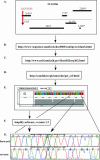Genome-wide single-nucleotide polymorphism map for Candida albicans
- PMID: 15189991
- PMCID: PMC420121
- DOI: 10.1128/EC.3.3.705-714.2004
Genome-wide single-nucleotide polymorphism map for Candida albicans
Abstract
Single-nucleotide polymorphisms (SNPs) are essential tools for studying a variety of organismal properties and processes, such as recombination, chromosomal dynamics, and genome rearrangement. This paper describes the development of a genome-wide SNP map for Candida albicans to study mitotic recombination and chromosome loss. C. albicans is a diploid yeast which propagates primarily by clonal mitotic division. It is the leading fungal pathogen that causes infections in humans, ranging from mild superficial lesions in healthy individuals to severe, life-threatening diseases in patients with suppressed immune systems. The SNP map contains 150 marker sequences comprising 561 SNPs and 9 insertions-deletions. Of the 561 SNPs, 437 were transition events while 126 were transversion events, yielding a transition-to-transversion ratio of 3:1, as expected for a neutral accumulation of mutations. The average SNP frequency for our data set was 1 SNP per 83 bp. The map has one marker placed every 111 kb, on average, across the 16-Mb genome. For marker sequences located partially or completely within coding regions, most contained one or more nonsynonymous substitutions. Using the SNP markers, we identified a loss of heterozygosity over large chromosomal fragments in strains of C. albicans that are frequently used for gene manipulation experiments. The SNP map will be useful for understanding the role of heterozygosity and genome rearrangement in the response of C. albicans to host environments.
Copyright 2004 American Society for Microbiology
Figures



Similar articles
-
Demonstration of loss of heterozygosity by single-nucleotide polymorphism microarray analysis and alterations in strain morphology in Candida albicans strains during infection.Eukaryot Cell. 2005 Jan;4(1):156-65. doi: 10.1128/EC.4.1.156-165.2005. Eukaryot Cell. 2005. PMID: 15643071 Free PMC article.
-
The Genome of the Human Pathogen Candida albicans Is Shaped by Mutation and Cryptic Sexual Recombination.mBio. 2018 Sep 18;9(5):e01205-18. doi: 10.1128/mBio.01205-18. mBio. 2018. PMID: 30228236 Free PMC article.
-
Identification of Recessive Lethal Alleles in the Diploid Genome of a Candida albicans Laboratory Strain Unveils a Potential Role of Repetitive Sequences in Buffering Their Deleterious Impact.mSphere. 2019 Feb 13;4(1):e00709-18. doi: 10.1128/mSphere.00709-18. mSphere. 2019. PMID: 30760617 Free PMC article.
-
Genome plasticity in Candida albicans: A cutting-edge strategy for evolution, adaptation, and survival.Infect Genet Evol. 2022 Apr;99:105256. doi: 10.1016/j.meegid.2022.105256. Epub 2022 Feb 26. Infect Genet Evol. 2022. PMID: 35231665 Review.
-
Molecular epidemiology, phylogeny and evolution of Candida albicans.Infect Genet Evol. 2014 Jan;21:166-78. doi: 10.1016/j.meegid.2013.11.008. Epub 2013 Nov 19. Infect Genet Evol. 2014. PMID: 24269341 Review.
Cited by
-
Demonstration of loss of heterozygosity by single-nucleotide polymorphism microarray analysis and alterations in strain morphology in Candida albicans strains during infection.Eukaryot Cell. 2005 Jan;4(1):156-65. doi: 10.1128/EC.4.1.156-165.2005. Eukaryot Cell. 2005. PMID: 15643071 Free PMC article.
-
Comparative Genomics Reveals the Core Gene Toolbox for the Fungus-Insect Symbiosis.mBio. 2018 May 15;9(3):e00636-18. doi: 10.1128/mBio.00636-18. mBio. 2018. PMID: 29764946 Free PMC article.
-
Evolution of pathogenicity and sexual reproduction in eight Candida genomes.Nature. 2009 Jun 4;459(7247):657-62. doi: 10.1038/nature08064. Nature. 2009. PMID: 19465905 Free PMC article.
-
Sequence Variation of Candida albicans Sap2 Enhances Fungal Pathogenicity via Complement Evasion and Macrophage M2-Like Phenotype Induction.Adv Sci (Weinh). 2023 Jul;10(20):e2206713. doi: 10.1002/advs.202206713. Epub 2023 May 21. Adv Sci (Weinh). 2023. PMID: 37211685 Free PMC article.
-
The evolution of drug resistance in clinical isolates of Candida albicans.Elife. 2015 Feb 3;4:e00662. doi: 10.7554/eLife.00662. Elife. 2015. PMID: 25646566 Free PMC article.
References
-
- Brumfield, R. T., P. Beerli, D. A. Nickerson, and S. V. Edwards. 2003. The utility of single nucleotide polymorphisms in inference of population history. TREE 18:249-256.
-
- Calderone, R. 2002. Candida and candidiasis. American Society for Microbiology, Washington D.C.
Publication types
MeSH terms
Substances
Grants and funding
LinkOut - more resources
Full Text Sources
Miscellaneous

